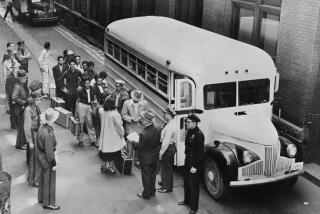San Jose’s Latinos Howl About Plans for a ‘Conquest Statue’
- Share via
SAN JOSE — Today’s anniversary of the 1846 raising of the American flag in San Jose will go unmarked by speeches or parades--but it will not pass unnoticed.
Verbal fireworks have blazed for months as news spread that city leaders had decided to put up a bronze statue commemorating the little-known event in the Mexican-American War. It has proven to be a political faux pas of monumental proportions.
Capt. Thomas Fallon’s ride into San Jose to raise the flag was a relatively insignificant footnote in the conflict that gave the United States control of California and much of the Southwest. But local Latino leaders say plans to immortalize Fallon in bronze represent a major slap in the face to San Jose’s 180,000 Mexican-Americans.
“The theme of the statue is a time period when the Mexican people were being taken over by the U.S. It’s a conquest statue,” said Felix Alvarez, director of a Chicano theater group called El Teatro de los Pobres. “But the real issue is not, ‘What are we going to do with the Fallon statue?’ The issue is, ‘What went wrong with the art selection process and who is responsible?’ ”
An angry community movement has galvanized around the Fallon statue dispute, calling for better minority representation in city government. But, as one local historian put it, some of the monument’s supporters see the whole debate as “much ado about very little.”
The Pueblo Unido de San Jose Coalition of 19 community groups charges that Mayor Tom McEnery and other politicians who chose to remember Fallon are insensitive to the concerns of minority ethnic groups that make up more than half the city’s 750,000 population.
McEnery says that’s not true, and that the Fallon statue is just a small part of a San Jose history revival that includes a new educational program in the city’s schools and efforts to remember the area’s past from pre-Columbian days through the periods of Mexican and U.S. government.
McEnery, who has written a fictional account of Fallon’s exploits, denies charges that he pushed the monument because of his interest in the saddle-maker and adventurer’s life.
Although Fallon was no great soldier--he was not enlisted in the Army, but volunteered to carry a flag over from Santa Cruz after U.S. soldiers planted one there--he later settled in San Jose and entered local politics. He served a year as mayor, and married a woman from a prominent family of mixed Mexican and European heritage.
“There’s much discussion and misinformation about Fallon,” McEnery said. “But he was probably part of the beginning of assimilation in our area. In a lot of ways, he’s a very good example of the mixing of cultures.”
That’s not the point, critics said.
“The very few people are making the decisions for the larger community, and there’s no sensitivity there,” said Pueblo Unido member Kathy Chavez Napoli. “Instead of any recognition that we have valid concerns, we get labeled as rabble-rousers.”
Latino and other ethnic group protests have prompted the San Jose City Council to drop plans to place the statue in a prominent location on a triangular traffic island near Plaza Park. Council members agreed to form an arts committee to decide where to put the larger-than-life likeness of the flag-toting Fallon and another rider. The statue itself cost $440,000, half to be paid by the city’s Redevelopment Agency, half by a downtown developer. The cost of putting it on a refurbished traffic island was projected at close to $1 million, to be split similarly.
Another part of the committee’s job will be to develop a list of art subjects from all periods of San Jose’s history, said John Lusardi, assistant to the executive director of the San Jose Redevelopment Agency. The Redevelopment Agency, which is made up of City Council members, plans to include more historic works in the city’s public art program.
The new panel, the Historic Art Advisory Committee, will include eight members representing major ethnic groups of the community and seven representatives of existing city arts committees. The group will draw up a plan to give city residents a greater say in how the city spends money on art in the future, Lusardi said.
But there still are those who don’t want the Fallon statue--on its way to San Jose from Italy where it was cast--no matter what. Some believe that the bronze adventurer will fall victim to vandals if he shows up in the city at all. The Redevelopment Agency, however, still is hoping to see the monument safely in place.
“The agency hopes the Fallon statue will go up somewhere in the city,” Lusardi said. “It’s still a work of art and a historic piece.”
More to Read
Sign up for Essential California
The most important California stories and recommendations in your inbox every morning.
You may occasionally receive promotional content from the Los Angeles Times.













